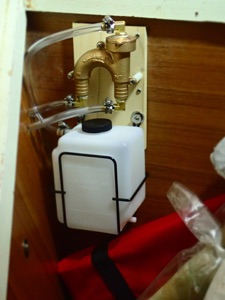Adding an Auxiliary Fuel Tank
Friday, July 3, 2020
We are currently sitting at anchor in the Great Wicomico River, waiting for the 4th holiday to pass so we can get on to Baltimore. Not a lot to do here so we decided to do a project log entry on how, and why, we added a below-deck auxiliary diesel fuel tank.
La Vita has two fiberglass diesel tanks under the floor on either side of the engine. Each tank holds approximately 65 gallons but, over the years, a slight leak has developed at the top of each tank where the deck fill pipe attaches. When full, the tanks can slosh a little fuel out. This fill pipe is impossible to get to without tearing out most of the galley and nav station, so we keep a small oil-absorbing pad under the drain on each side and replace them occasionally. To minimize the sloshing, we only fill the starboard fuel tank to 55 gallons and the port to 64, giving us a maximum fuel capacity of about 120 gallons. This gives us an approximate motoring range of 700 nautical miles, if we don’t also run the generator.
As a side note, long ago we adopted the procedure of only adding fuel to the starboard fuel tank and only running the engines off the port fuel tank. To move diesel from one tank to the other, we use a transfer pump with a two-micron filter. One of the most common engine problems is contamination and algae growth in diesel fuel and we have found that this, along with scrubbing the inside of the diesel tanks every 3-4 years, greatly reduces the chance of gumming up our fuel lines.


Some people wonder why we need more than 120 gallons of diesel. After all, we are a sailboat and the wind is free. Truth be told, if you are just out for an afternoon sail and return to your home marina at the end of the day, that is correct. But when you are cruising and trying to get from one place to another, the wind is rarely agreeable. It is either on the nose, off the stern, too little, too much and we end up motoring or motorsailing the majority of the time. Plus we like the flexibility of purchasing diesel when it is most convenient and cost effective.
To increase their motoring range, a lot of cruisers tie diesel jerry cans on their side decks. We considered this, but our side decks on La Vita are narrow so any jerry cans would have to be mounted pretty far forward. The further forward the jerry cans are mounted, the more vulnerable they are to being ripped off by a boarding wave, along with the life lines they are attached to, during a rough sea way. Plus the diesel has to be poured from the jerry can into the deck fill hole and this can be hard to accomplish at sea and the diesel has to be lugged from the shore to the boat in a dinghy and hoisted aboard for storage. So we decided to find a place to add a third fuel tank below deck.
Any place we picked had to fit a couple of important criteria: first, it had to be large enough to make it worth the effort and, equally important, had to offer good attachment points to firmly anchor the tank in place. The area under our stateroom bunk fit both these criteria. It is mostly bulk storage divided into two large compartments. The forward compartment holds our spinnaker and sewing machine. The aft, being more difficult to get to, only held diving equipment and had lots of extra room. This aft compartment was ideal.
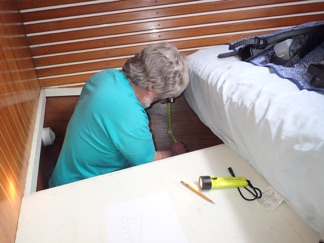
Our Handcraft mattress has a hinge in the middle and folds up. Then it could be moved forward to allow access to this aft compartment. There was a structural stringer down the outside of the compartment and a strong floor, allowing good attachment points so the tank, once installed, would not move even in a rough seaway.
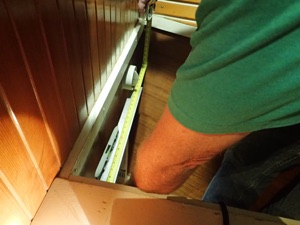
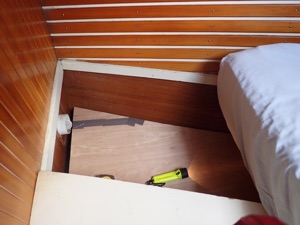
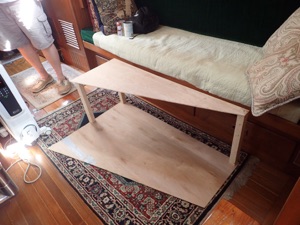
Careful measurements were made and we built a model of the top and bottom. We had to leave room on top for the piping and to stash the scuba gear back away but once the model was made, it looked like we could get a 45-50 gallon fuel tank built for the space. This would be like nine jerry cans! Drew created a CAD drawing with precise measurements and we contracted with Mike Shahan at S&S Marine in Norfolk to build the tank. We would pick it up on our way south in the fall.
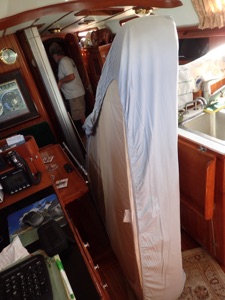
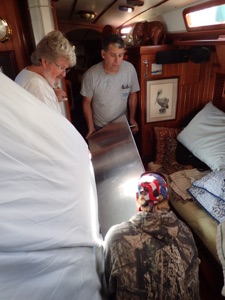
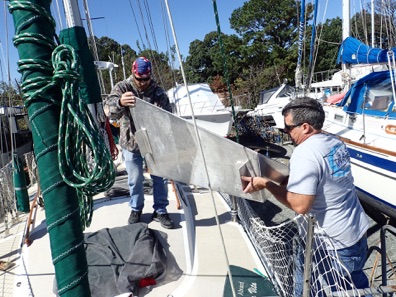
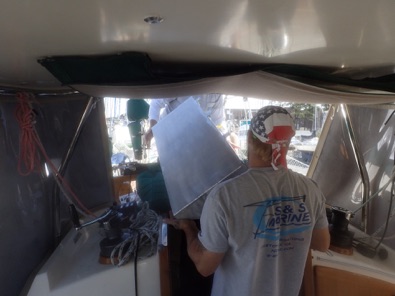
When we got back to Cobb’s Marina for our bottom job, Mike and a helper brought the tank over for a preliminary fitting before finishing the welds. We totally removed the mattress and they carried the tank up the ladder onto the foredeck (since we were on the hard) and carefully slid it through the front opening of the dodger and carried it below.
The tank fit perfectly! So Mike took it out and back to his shop for the final welding. He built the tank with baffles so we won’t hear diesel fuel sloshing around under our bunk at night and he put an opening in the top for the Maretron tank sensor that we will use to determine the amount of fuel in the tank instead of a dip stick.
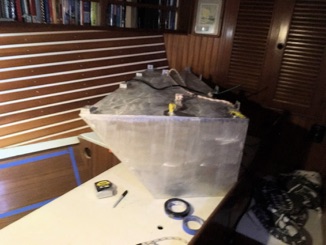
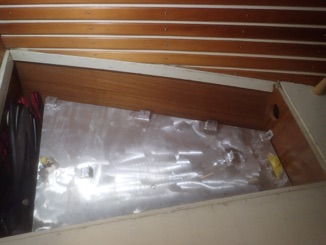
The rest would be up to us. We temporarily secured the tank, finished our bottom job at Cobb’s and headed south for the winter.
A lot of life happened that next winter and summer. Drew had shoulder surgery and the recovery took longer than expected. We also went to Spain and Portugal and then took La Vita north again, out of the hurricane zone. But the following winter we started making real plans to complete plumbing the tank as we hoped to sail to Bermuda.
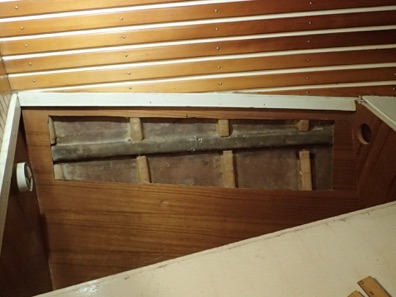
The first step was to permanently mount the tank. We cut away the teak lining around the stringer and built mounts out of a G10 fiberglass board. G10 is a highly compressed, extremely strong sheet of glass epoxy laminate that can be fiberglassed to other surfaces.
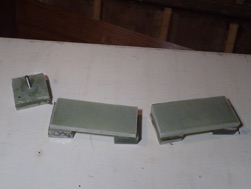
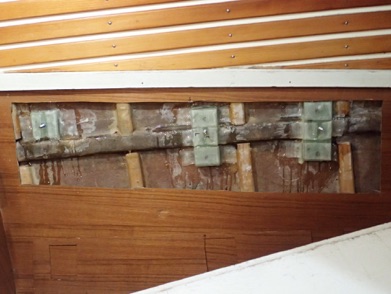
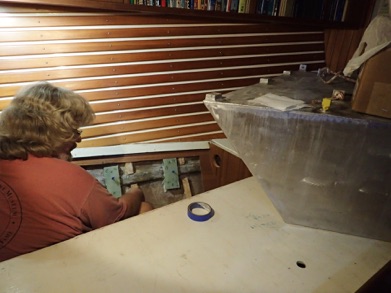
First the G10 mounts were fiber-glassed to the stringer, then the mounting hardware was attached to the G10 and to the mounts that were welded on top of the tank.
We knew that this would involve Drew spending quite a bit of time in the hole that was our bed so we timed this project to coincide with our time in Orlando with Drew’s dad, George so that we could leave the bed and tank out and Drew could commute from Orlando to Cocoa to do the work.
In the meantime, we had driven to Ft. Pierce to Marine Liquidators to buy fuel hose (best prices on hose that we have ever found) for the plumbing and ordered a two-way transfer pump.
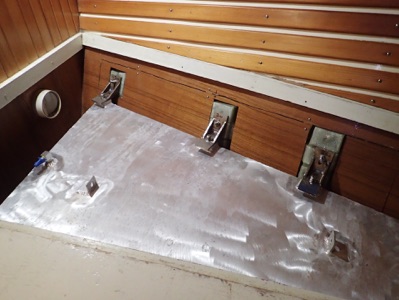
After all the mounts were complete, we reinstalled the teak trim and started to work on the support of the bottom of the tank. Even though the floor underneath the tank was well built, the tank itself weighed 50 or so pounds and when full could weigh up to 350 lbs full of diesel.
For a floor support, we took more G10 and built a crutch that we glassed to the hull and encapsulated the floor support but was not attached to it so the hull could flex as it needed to when sailing.
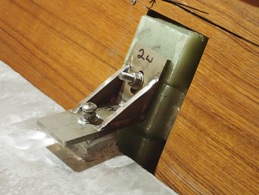
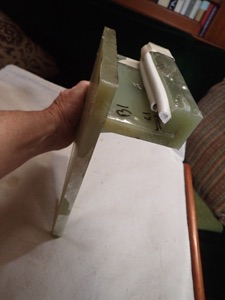
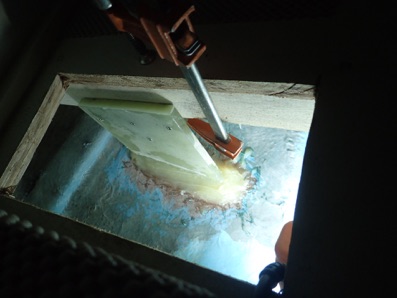
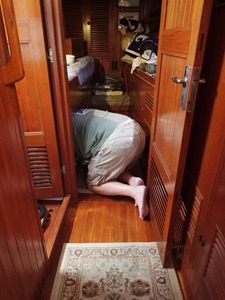
To reach this space, we had to remove some drawers that are under our bunk and Drew had to spend a lot of time crunched up in the very small forward stateroom floor. But in the end it was done and we were happy with the mounting.
Next it was on to running the plumbing. Since we only fill the tanks from the starboard and run them from port, this new forward tank would be filled and emptied through the starboard tank so we didn’t have to add more fuel filters. And everything had to be labeled well so that we didn’t accidentally overfill the tank and have a mess to clean up under our bunk.
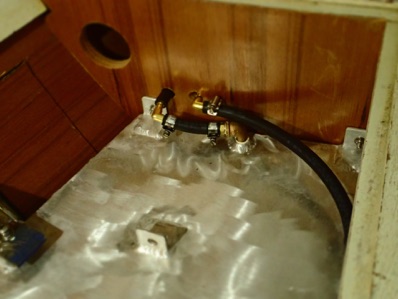

Luckily the transfer pump and the switch box fit on the shelf next to the starboard fuel tank that also holds our secondary bilge pump.
Snaking new fuel hose in a 37-year old boat is not easy and it took quite a while but we had overestimated the amount of fuel hose necessary so we could have some latitude on its direction.
We also installed a siphon break next to the new fuel tank and installed an overflow tank (similar to one on a radiator) in case it sloshed when underway.
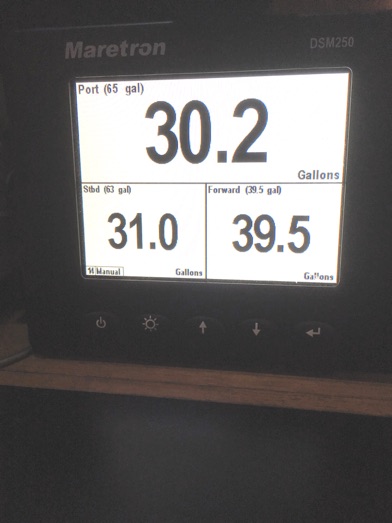
The first time we filled and calibrated the new tank, we used the Maretron feature that let us tell it the shape of the tank and every time five gallons was added. Stephanie watched the overflow tank while Drew filled it the last few gallons so we know exactly how much was in the new tank. Not quite the 50 gallons we had hoped but 39.5 extra gallons of diesel could make all the difference if we find ourselves needing to motor to a port or waiting to fill the tanks until we get somewhere that diesel is cheaper than Nova Scotia or New York. After we finished filling and calibrating the forward tank, we calibrated the other two tanks so hopefully can transfer fuel a little quicker in the future than only using the dipsticks. On a busy weekend, we feel guilty tying up the dock while we slowly move fuel to the port tank.
The cost for adding the fuel tank, including the tank, pump, plumbing, mounting and Maretron sensor was about $2,000. That is a lot more than ten jerry cans but we are very happy with the final product and someday, when this COVID-19 pandemic is over and we are able to sail somewhere outside the US, it may make all the difference in whether we can make it to the next port safely. Until then, we will be happy not to have jerry cans on the deck and to be able to fill up when diesel is cheap and convenient.
